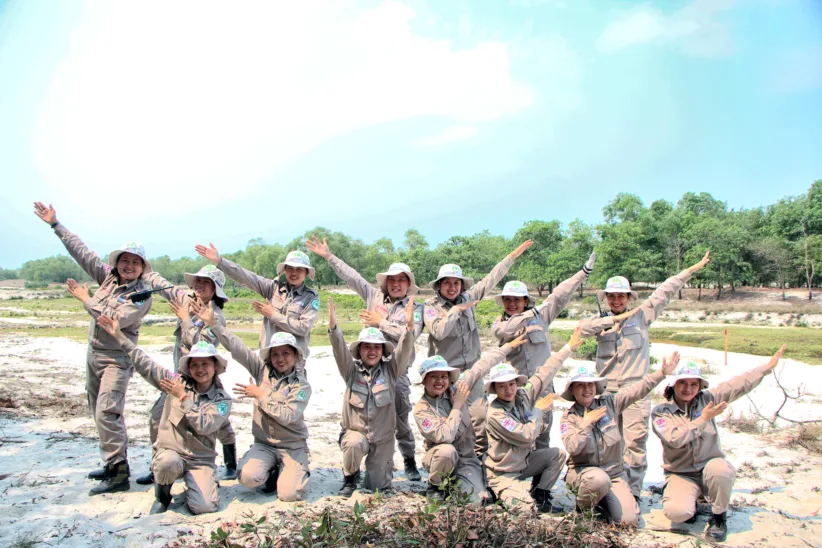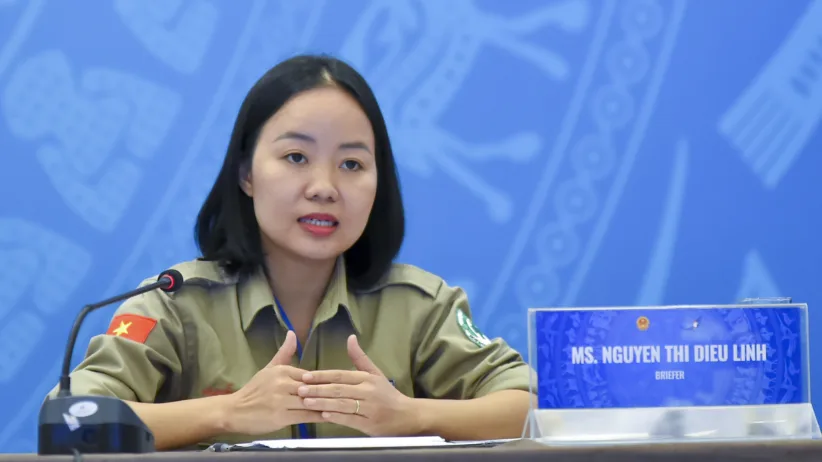Female deminers in Vietnam rid local communities from explosive remnants
Nguyen Thi Dieu Linh manages all Norwegian People's Aid's activities in Vietnam's Quang Tri province. The recipe for success has been determined work combined with an unusually high dose of passion for the job.
Didn't understand how dangerous the UXOs were
Linh was born into a farming family in Dakrong district, a mountainous area in the south west corner of Quang Tri province. Her mother sold spare parts for bicycles and motorbikes, and her father worked for the Commune People’s Committee.
“We were quite poor,” Linh explained, “but they worked hard, and tried to earn enough money to have enough food just for today and tomorrow.”
Despite the extraordinarily high level of contamination from explosive ordnance in Quang Tri province, Linh never really had a strong understanding of its impact in her village when she grew up.
“I don’t remember being taught about explosive ordnance when I was a child,” she recalls. “In school there was a subject about history, but no risk education, so I was not really aware of this problem.”
However, she often came into contact with explosive ordnance when she was playing with her friends in their village after school. “We lived in an area that was a former US military base when I was five or six years old,” she said. “I did find a lot of 40mm grenades – but I was not aware that they were explosive ordnance and so I didn’t understand that it was dangerous. I only realised what it was after I started working for NPA.”
The Vietnamese Demilitarised Zone
In many ways, Quang Tri province is synonymous with the Vietnam War. Famous names like Khe Sanh, Ben Hai, Con Thien, Hien Luong and Vinh Moc are still found on maps, reminiscent of the conflict that devastated the province less than 50 years ago. The province is home to the 17th Parallel, the demilitarized zone drawn to divide North and South Vietnam from 1954 to 1975.
The Ho Chi Minh Trail – a famous network of roads and trails that moved troops, weapons and supplies from Northern Vietnamese forces to their supporters in the South – weaves through tropical forest in the mountains to the west. Dong Ha, the provincial capital, was the northernmost town in South Vietnam and home to an important US combat base until 1972. This dangerous trifecta of geographic location made the province of critical importance to both sides of the conflict, and saw it suffer from some of the heaviest bombing the world has ever seen.
A 1972 article from the New York Times describes a mid-war Quang Tri province as “an unrecognizable wasteland of smashed buildings and craters… the Americans with their bombing and the North Vietnamese with their shelling had reduced Quang Tri to ruins.”
Today, the dusty main street of Dong Ha is lined with largely unremarkable concrete architecture, a result of quick reconstruction after the town was levelled during the war. Only a few kilometres past the main street, Dong Ha’s markets and restaurants quickly fade into the sprawling rice paddies, fishing villages and tree plantations that cover most of the province. It is in Dong Ha that Linh spends each day overseeing nearly 300 staff who continue to find and clear the explosive ordnance that has littered the province for 46 years.

Ambitious from day one
NPA began operations in Vietnam in 2007, in Thua Thien Hue province, which shares the southern border of Quang Tri. Today, NPA works in three provinces, with views to expand into more heavily-affected provinces further south, and conducts cluster munition remnants survey, clearance and capacity development activities in support of national and provincial mine action and development strategies.
Linh started working for NPA as a translator in 2010, when NPA expanded activities into Quang Tri in an enduring partnership with provincial organisation Project RENEW. Despite having no knowledge about mine action, she has determinedly learned as much as she could, and moved up through NPA’s ranks: first to Operations Assistant, then Operations Officer, then Operations Manager and now to Provincial Programme Manager. In her current role she is responsible for all activities in Quang Tri province, from overseeing finance and operations, to donor reporting, to coordinating with provincial authorities and partners.
At the same time, she’s raised a family. Linh and her husband are proud parents to two girls. “My eldest girl says that she knows my job is good for people, that I’m helping people,” Linh says. “My whole family – my parents, sister, husband – they’re really proud of me. Really proud,” she says with a smile. When asked if she has any trouble balancing her work and home life, Linh laughs. “I’m quite lucky that my husband is very supportive and helpful, we really work as a team. My husband is one of the best,” she says.

Uplifting women
Linh’s dual role as mother and mine action operator is not as uncommon as it might appear. In NPA Vietnam, women hold nearly 30% of all positions, and half of all senior management positions. However, this hasn’t always been the case. “When I started to work in mine action, it was only a few women working in operational roles and usually as a medic or translator.” Linh explains. “People now see women working in mine action as something normal now, but they really respect the women working in mine action as very strong and very brave.”
Nowhere is this demonstrated more clearly than with NPA Vietnam’s all-female battle area clearance team – the first of its kind in Vietnam. The 17-person team spends each day surveying and clearing explosive ordnance in villages across Vietnam. In 2020, these women cleared over 740,000 square metres of land and destroyed over 680 items – which proves that women definitely do the work in mine action, and do it just as well as men. Linh oversees the daily activities of this team – and 24 others who conduct a variety of activities in Quang Tri.
“Many people think that because I’ve been working in the same programme with the same activity, I must be bored,” Linh says. “But what I like with my job is that every day is not the same – we are always trying to improve and find ways to work better. So, I always learn a lot more and contribute more in the development of methodologies or improving different procedures. I really like this kind of environment – working and learning and contributing.”

Gave testimony to the UN Security Council
A great testament to Linh’s dedication to mine action in Quang Tri province was when she was personally invited by the Vietnam Ministry of Foreign Affairs to brief the United Nations Security Council in 2021. “I was very proud to speak at such a high level,” Linh said.
While Linh was doing final rehearsals for her briefing to the Security Council, one of the battle area clearance teams she oversees in Quang Tri province located 495 explosive items – mortars, grenades and rockets – buried in an area of less than 15 square meters. As Linh sat in Hanoi testing the video conferencing software used by the Security Council, her phone buzzed continuously as she confirmed the team’s response to the find: render the ordnance safe, transport to it to a central location, and prepare it for safe disposal. The items were destroyed by NPA’s explosive ordnance disposal team, supported by provincial operations manager Mai Van Viet and Norwegian and British technical experts, in a series of six demolitions the following day.
Seeing things like this makes me even more determined to continue my job with my teams. I love what I’m doing, and whatever I’m doing I will do the best I can – and that makes me happy.
“This is just one of the tasks, one of many tasks we are doing every day,” Linh explained. “It is a very real and clear example of the remaining scope of the contamination problem, and shows the importance of the work that we do.
“Before this, we have found EO under roads that people use every day, in rice fields that farmers plough every year, and even school yards and in the foundations of people’s houses.
“Seeing things like this makes me even more determined to continue my job with my teams,” Linh says. “I love what I’m doing, and whatever I’m doing I will do the best I can – and that makes me happy.”
